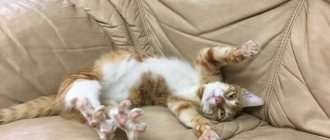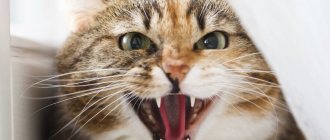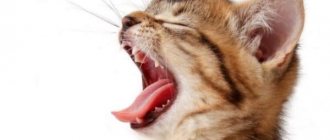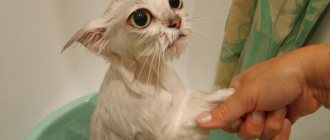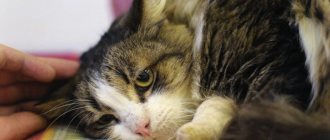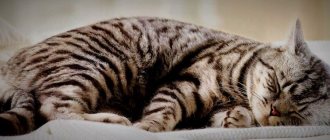Photo: TASS/Yuriy Smityuk
Cats are the most popular type of pet on the planet. We like them, we look at them on the Internet, tell stories about them and have them in our homes. But do we know everything about them? What secrets do our pets hide?
There are many superstitions about the mysterious abilities of cats. They are credited with nine lives, the ability to treat human diseases, and even connections with the other world. We decided to check the most common myths and understand what is true and what is mere fiction.
The incredible survivability of cats: a plane crash in 2011
I remember my grandmother telling me that cats are very tenacious creatures. They can fall from the fifth floor and not break. Of course, I didn’t try to conduct experiments, but I still heard more than once about this ability of moustaches. And just recently I came across this story.
On July 11, 2011, a fire was recorded on the AN-24 plane flight Tomsk - Surgut. The plane needed to be landed urgently, and the pilot made an emergency landing on the Ob River. Some of the victims were rescued. There was a cat on that flight that was not found as a result of the search.
Photo: TASS/Zurab Javakhadze
The wreckage of the plane began to be lifted from the water only eight days later. When it came to the cabin, the same lost cat named Chamomile jumped out. She ran away into the forest and came to people only a month and a half later.
In that plane crash, the cat Romashka risked dying more than once: she could have crashed against the bars of her cage during a hard landing, drowned in the water, or died of starvation in a flooded airliner or while wandering through the forest. But she managed to avoid all this. Maybe cats really have nine lives?
This is a real life story, and I will not judge whether it is an accident or not.
The energetic power of cats
They say that cats have strong energy. Let's try to look at a pet from the point of view of extrasensory perception.
Photo: YAY/TASS
“A cat is an energetic substance, invisible to us, trembling, of a very high level, high frequency, that is, energy goes back and forth, it is not 220 volts in the current, digital representation. It's probably about a thousand volts. And this energy substance, thousands of volts, has eyes at the top that emit this energy in a living stream,” says psychic Arina Evdokimova.
The energy clot that a cat represents cannot be destroyed, the psychic believes. This is where those nine lives come from. Falling from a great height, finding itself in situations on the verge of life and death, the animal simply reincarnates. Of course, the human eye cannot see this.
The Institute of Ecology and Evolution studies the habits of all felines. Zoologist Anastasia Antonevich says the reason cats are so resilient lies in their behavior before they became domesticated. That is, the conditions of the wild in which they were for a long time were clearly reflected in the genetic code of the animal. This is why cats are so highly adapted to survival.
“In life they have adaptations to jump well, fall well, because they climb a lot, and also it has to do with how they hunt. Due to the fact that they hide, they have a very flexible gait, flexible movements, a very flexible body,” says senior researcher at the Institute of Economics and Economics named after. A. N. Severtsova RAS Anastasia Antonevich.
Cat Anatomy: The Key to Strength
There are 247 bones in a cat's skeleton, 41 more than in humans. The most parts are in the spine and tail. Thanks to this, the animal can bend twice and turn over 180 degrees even in flight.
Why does a cat always land on its feet?
There is a whole system at work here: the inner ear, the brain, the muscles and the spine. When a cat falls, it turns its head, and the fluid that fills its inner ear affects the millions of sensitive hairs located on the long, elongated cochlea. This is how information about the position of the body in space is transmitted to the brain, and we see how the animal lands on its paws.
Ability to go long periods without food
Cats gained the same vitality, as well as the ability to go without food for a long time, thanks to evolution and way of life.
Photo: m24.ru/Tatyana Ukhanova
In principle, it is typical for predators to be able to hunt and feed occasionally; cats are no exception.
But how do domestic, purebred, pampered cats find food for themselves in the forest, since in the wild the ability to hunt is inherited by their parents?
Interestingly, every cat knows how to hunt mice. This is an instinct or program that is laid down by the evolution of the entire species. But, for example, an animal can learn to hunt rats only if its mother teaches it. The art of hunting is passed on from the older generation to the younger.
Do cats feel death?
Scientists have been asking this question for a long time. The line between something mythical and connections with the other world is very blurry for cats.
In the American hospice Steere House there lives a cat named Oscar. He doesn't really like people and usually hides somewhere in the back rooms. But what's interesting is that he appears at the patient's bedside a few hours before his death. This was noticed by the staff of the medical institution. Oscar the cat lives in a ward for the weak-minded. These are people who are in dire need of support. But, unfortunately, when they go to another world, their beds are rarely surrounded by family and friends. Oscar the cat is often their only companion.
Photo: TASS/YAY/Denise Poloni
“There were situations where we had several people dying at the same time. I remember one case when we had two such people on opposite sides of the department. We all thought one of them was going to die, but Oscar was nowhere to be found. We started looking for him and found him on someone else's bed. One of the nurses picked him up and carried him into the hall, but Oscar ran away and went back to that patient. And he was right: that patient died. And the one we all thought would die lived a few more days. But a couple of days before that, Oscar came to him too,” says geriatrician David Dosa.
Why can cats sense death? Those who speak on the “magical” side of the issue say that animals can see the human soul. Moreover, both inside the material shell and outside it. A cat, from the point of view of psychics, is capable of moving from one world to another and communicating with the deceased relatives of the owner. Even in Ancient Rus', our ancestors noticed the ability of cats to foresee death. Many witchcraft rituals are based on this feature.
How can you tell if a cat is dying?
Superficial signs that the cat will soon leave our world are:
- An attempt at privacy. The cat is always going somewhere and doesn’t want to be with you;
- Quiet breathing. It seems that the pet is not breathing at all;
- Wheezing, like a person who has asthma;
- Body temperature decreases;
- The cat's voice becomes barely audible.
All these symptoms are not exclusively signs of old age. Sometimes, this is how some diseases manifest themselves. Therefore, it doesn’t hurt to take the cat to the vet. Perhaps the animal will still be able to live normally for a couple of years.
What to do if the cat dies?
If the cat is definitely dying of old age, it is worth brightening up his last days. Have your veterinarian prescribe pain medication or vitamins for your pet.
And you should not disturb the animal and create a good bed for it, where it can retire. You should also pay great attention to feeding your pet. After all, many old cats are not able to eat on their own.
Sometimes, it is easier to euthanize an animal so that it does not suffer. But this is a controversial issue. You can resort to this method only if the cat is really experiencing severe suffering and definitely cannot return to normal life.
What can a cat die from?
Many people believe that signs that a cat is dying may appear in old age. But there are a lot of diseases that can kill an animal. And these include:
- Ear mite;
- Feline immunodeficiency virus;
- Infectious enteritis (plague);
- Rabies;
- Urological syndrome.
A cat can become infected while walking outside or by eating its prey (for example, an infected rat). Many such diseases are completely curable. Therefore, it is necessary to take cats to the veterinarian every few months.
This will not only improve the health of the animal, but also prolong its life. After all, the less a cat is sick in its youth, the longer its noble old age will last.
How to cope with the death of a pet?
If the cat has died and you are worried, then you should get another animal. This way you will brighten up your loneliness and sadness. It must be remembered that cats rarely live more than 15-20 years. Therefore, if you take home an adult, sooner or later you will have to send it on its last journey.
It is also worth remembering that a normal death is much better than a life of torture. This means that the old pet has gotten rid of its torments and is worth rejoicing for.
To quickly forget about an animal, you can cremate it. Such services are offered in many cities. But burial causes additional negative emotions and makes you remember everything again and again.
And remember that a little pain of loss is a normal reaction of the body. But you shouldn’t grieve for more than a few days. After all, there are many stray kittens in the world that can become your new pets.
Unfortunately, nothing living on this earth lasts forever. Our beloved pets may also die sooner or later. This article will talk about how cats die.
The gift of foresight: cats save people
Scientists have long proven that cats sense vibrations in the earth's crust. The story of how the favorites saved the artist Dmitry Kuklachev is no longer new, but very interesting.
Photo: TASS/Interpress/Elena Palm/DESC]
2004 Dmitry Kuklachev was on tour in Japan.
“Just an hour before the start of the performances, I go to the cats and see that they begin to behave very unusually. That is, someone hisses, someone meows pitifully, someone jumped on the windowsill and scratches at the window, someone hid in a corner. And when you approach them, you start stroking them - then you come to your senses a little, but at the same time you feel some kind of apprehension, some kind of tension in them,” says trainer Kuklachev.
For the translator who was nearby, the cats' behavior was not a mystery. This always happens before a powerful seismic attack. He immediately ordered Kuklachev to run away from the theater building.
“In general, all the artists took the cats under their arms and ran out into the street. The crowd is noisy around, everyone is talking. We stand there for 10–15 minutes, nothing happens. I say: “Igor, listen, maybe the cats made a mistake?” — Dmitry Kuklachev.
And suddenly three powerful shocks with a force of 6 and 8 shook the earth. People threw themselves onto the asphalt, covering their heads with their hands. At this time, the cats were tearing out of their hands and trying to rush to a safe place. The shaking stopped after a few hours. When Dmitry returned to the theater building, the hall was completely destroyed.
And this is not the only case where cats saved people.
Live locators
Not only rats have the ability to sense the approach of trouble. The title of “living locators” rightfully went to domestic cats. During World War II, muroks were used as predictors of airstrikes. Before enemy raids, the cats behaved unusually - they hissed, hid, and tried to leave the house. The owners realized that the strange behavior of their pets warned of the need to go to a bomb shelter. The cats even received a special award for their extraordinary abilities. During wartime in Great Britain and France, cats that helped save human lives were given a medal with the engraving “We, too, serve our Motherland.”
Cats' ability to foresee disasters is still used today. Thus, in earthquake-prone areas it is difficult to find a house without a cat. Residents of dangerous places noticed that the Murki know about future earthquakes and volcanic eruptions no worse than scientists.
But what do cats feel? According to one version, they have finer hearing than humans, so they can detect microseismic vibrations in the earth’s crust; according to another version, animals sense changes in the earth’s magnetic field before volcanic eruptions or tremors. However, neither one nor the other version has ever been confirmed. Skeptics even believe that all the described examples of animals warning people about impending disaster are nothing more than an accident.
But, despite the fact that the amazing abilities of animals have not received confirmation from official science, people try to use such signs. So, in 1975, noticing the unusual behavior of zoo inhabitants and pets, the Chinese authorities evacuated the population of the entire city, which was soon completely destroyed by a magnitude 7 earthquake. Such “observation” of animals allowed saving more than 90 thousand lives.
Felinotherapy: treatment with cats
I remember when I was a child I had a severe stomach ache. My beloved cat Musya lay down on it and lay there for about half an hour. The pain went away, and then the cat ran away about its business. I don’t know what it was connected with, the warmth or something else, but it helped me. It turns out that there is a whole system of treatment for cats called feline therapy.
Photo: TASSPatrick Seeger/ DPA
The most common issues referred for therapy are the musculoskeletal system, cardiovascular diseases, blood pressure and depression.
Why does a cat lie down on sore spots?
This also has an explanation from the point of view of official medicine.
“A cat is more sensitive to an increase in the temperature of the human body, and at some subconscious level determines the location of inflammation, because the main signs of inflammation are local increases in body temperature, including the skin. And the cat is located in this zone of the human body and, accordingly, tries to warm up, somehow heats the tissues, due to this there may be some increase in local blood supply, a slight reflex effect. During purring, a slight vibration occurs, and due to this, perhaps, at some reflex level, there is a decrease in pain symptoms at the site of inflammation,” explained physiotherapist Evgenia Khalelova.
Purr
Scientists have not yet revealed the secret of the purring itself. In the wild, cats make such sounds extremely rarely and only when communicating with newborn kittens. The mother, purring, licks them. When the offspring grows up, the predator is no longer capable of such tenderness. She can't bring herself to purr on purpose. So why does a domestic cat love to purr so much? Does she really perceive the owner as her own child and care for him? For zoologists this is still a mystery.
Natural instinct of cats
In the wild, animals also look for a secluded place, since dying animals become easy prey for predators.
Leaving the usual habitat is due to the desire to leave the pack, remain alone and protect the weakened body from enemies.
Most likely, the domestic cat is also guided by this instinct of self-preservation. She, like her wild relatives, seeks to hide from stronger opponents, from whom she cannot defend herself due to physical impotence. Today, this is the most plausible and logical version of why cats leave home to die.
Vet
Cat owners are usually very upset that their pets always want to leave their “father’s home” before they die. What motivates them and what do they feel at the last moment?..
“One day the cat left the house never to return. He had a presentiment of the inexorable approach of death and was preparing to meet it, as befits a wild one - alone. He did not want to die, smelling a human smell and hearing a human voice. And until death struck its final, quick and sudden blow, with the last of his strength he crawled to where a proud wild animal should die - not to soft pillows, but to a lonely quiet place in which he could leave with dignity. this cruel world." Aldan Devo, Cats
People are surprised and do not understand why their pets reject possible help when they feel that they are truly seriously ill or infirm.
Do owners really, even with all their love, mean nothing to cats? And leaving people at such a moment once again proves this?
However, you should not reproach yourself in vain. The phenomenon of lonely death is by no means new. One eastern author wrote back in 1708 that a distinctive feature of cats is their disappearance from the sight of people, so that representatives of the human race do not accidentally catch their dying gaze, which is truly terrible. Most likely, we are dealing with some kind of phenomenon. And since such cases are not isolated, they represent a typical example of cat behavior. If we were talking about just a few cases, then one might think that death simply overtakes animals just at the moment when they find themselves far from home. However, this is typical for cats, and this behavior is unlikely to be explained in this way.
To understand the behavior of cats, it is very important to consider how they think about death. All people know that they will die someday and behave accordingly. Cats have absolutely no idea about their own death and, therefore, cannot foresee or sense it, no matter how seriously ill they are.
An attack of illness means for a cat, as for any other animal, that something wrong is happening to it. If they feel pain, they believe they are being attacked. It is very difficult for an animal to distinguish one type of pain from another. If the pain intensifies, then the cat understands that the danger is serious. If a cat does not see the source of danger, it means that it does not know what to protect itself from. There are two options left: run or hide. If pain overtakes a cat while walking, then its natural reaction is to hide from the “attacker”. If she sees a barn or any other shelter, she will certainly use it to hide, to remain alone, waiting for the danger to pass and the pain to subside. The cat does not dare go out as long as it feels that the source of the pain is still there and waiting for it, and therefore remains in its hiding place, dying alone.
Contrary to all kinds of assumptions, at the moment of death, a cat does not think at all about the feelings of its owners, but only about how to protect itself from the terrible invisible danger that causes so much suffering.
Cats and evil spirits
Why is a cat often associated with evil spirits in folk superstitions?
“Let’s imagine a session of exorcism - expelling a demon, evil spirits from a person. This evil spirit came out, he didn’t crumble, he came from some parallel world, he doesn’t know where this parallel world is. And nearby there is an animal - a dog, a cat, a pig. Of course, the evil spirit will enter the cat faster. She is closer to him in energy substance, that is, in terms of charges she is closer to him. He possessed her. And therefore, from here, I think, sometimes a cat behaves inappropriately, because it has attracted an aggressive energy being. Why does she behave physically aggressively: she grumbles, bristles, I don’t know what she’s doing. She tries to throw this creature off of her. This way she gets rid of negative energy. She’s trying to physically burn her,” explains Evdokimova.
Sudden aggression in cats is caused by increased sensitivity. In the corners of their nose there is an additional organ, which even scientists sometimes call the “third eye.” This is the Jacobson organ. It is able to detect pheromones and distinguish hormones by smell. This explains the apparent emotional sensitivity of cats. When the owner is happy, the pet seems to support him. But in fact, this is how she reacts to the hormone endorphin. Cats actually have a very limited emotional spectrum.
“Their higher nervous activity is very poorly developed. Therefore, in principle, cats are very simple creatures. They have everything at the level of reflexes and instincts. They cannot feel guilt or care about someone. They live precisely by reflexes,” explains zoopsychologist Irina Safonova.
The belief that cats are possessed turned out to be a myth. Any aggression in an animal is caused by something. After all, in every Murka, even if it never leaves the apartment, there lives a wild predator. And almost all miracles can be explained by the increased sensitivity that nature has endowed them with.
Do cats and dogs feel the approach of their death and which of them is more “emotional”? Dmitry Zhukov , Doctor of Biological Sciences, Associate Professor, Senior Researcher at the Laboratory of Comparative Genetics of Behavior at the Institute of Physiology named after A.
I. P. Pavlova RAS, laureate of the Enlightenment Prize (book “Stop, who is leading? Biology of human behavior and other animals” 2013). Well, if animals feel their death, it is not sudden - many cat corpses lie on the highways. Leaving home before death is most likely a manifestation of depression. When a person is physically unwell, he also wants to be left alone.
Even if animals leave home to die, none of the naturalists reported such “cemeteries.” The corpses of cats that are found in cities usually have severe injuries. The desire of cats to “not upset” their owners is not scientific.
In addition, many cats and dogs die peacefully in the home where they lived.
Scientists know that animals mourn their deceased comrades. For example, dolphins and monkeys touch dead members of their pod. But to interpret these stories as the fact that animals pay honor to their dead relatives is romantic, but not very scientific.
As for cemeteries in the animal world, it’s possible. After all, the custom of burying the dead in the ground arose among our distant ancestors precisely as a way to reduce the attractiveness of our habitat for predators.
In simple words - so as not to attract the main predators of primates to our cave - leopards, who also feed on carrion. By the way, at the beginning of the twentieth century in British India, man-eating leopards appeared precisely after epidemics, when they did not have time to burn the dead, or in mountainous areas where there was not enough wood, and the dead were thrown into the abyss with coal in their mouths.
Dogs against epilepsy
There is another statement - that dogs and cats not only feel where the owner hurts, but also “understand” if the owner is about to die. This is absolutely scientific! Pets really “understand” that the owner will soon die - if the disease reaches the final stage and the changes in the body are already very strong.
Dogs are trained to alert epileptics to a seizure. Perhaps the main danger to the life of a person with epilepsy is the unpredictability of an attack. Living with the constant threat of falling into convulsions at any moment is chronic stress.
Because of this, secondary changes occur in the patient’s psyche. In addition, the suddenness of the attack creates a high risk of fatal injuries.
Not to mention if a person leads an active lifestyle - drives a car, works in production, etc.
And dogs feel the approach of a seizure 20 minutes before and, naturally, worry - they understand that something abnormal is happening to the owner. After training, they can give the owner a clear signal - for example, take his pant leg (the hem of a dress) in his teeth or show some other behavioral reaction that the dog does not show under any other circumstances. The person manages to take the medicine, lie down in a safe place, and warn other people.
What exactly dogs feel in these cases is unknown. Perhaps their subtle sense of smell or hearing is working. Dogs have recently been shown to sense changes in the magnetic field. This possibility cannot be ruled out—human magnetic fields have been practically unstudied.
Dogs also sense critical changes in blood sugar in a diabetic owner. It is obvious here that their sense of smell is at work. Just like when diagnosing cancer with the help of dogs.
In this case, we can say that the dog has a presentiment of the death of a person, because the success of diagnosing oncological diseases is much more impressive than their treatment.
The broken dreams of a police dog
Let's assume that the pet's owner dies. Here another judgment arises: that dogs are sad for people, but cats are not. A very interesting question - are cats less emotional than dogs? This is an incorrect statement, and the question is incorrect. Based on the duration of lying on the owner’s grave, it is impossible to talk about differences in either the emotionality or memory of cats and dogs.
What is "emotionality"? Emotions are a subjective and intimate thing. We judge other people's emotions by changes in their behavior, in particular by their facial expressions. Moreover, we base these judgments on the transference of our feelings to other people. If I cry when I feel bad, then if another person cries, it means he feels bad too.
If I wrinkle my forehead when I am puzzled by something, then another person with a wrinkled forehead also finds it difficult to make a decision at the moment.
It is wrong to talk about the weak emotionality of those people who have weak facial expressions. Such people can experience strong emotions, and long-lasting, stagnant ones. They are simply not reflected, or are weakly reflected on their face.
As for assessing the emotions of animals, everything is even more complicated, and anthropomorphisms lead to false conclusions. For example, German Shepherds have raised inner corners of their eyebrows when at rest. This gives the dog's face an expression of sadness.
This is a common expression for this breed. It disappears when the animal runs, actively sniffing out something, or chases birds, or when it communicates with the owner - listens to his commands, or instructions, or reproaches.
But when a shepherd dog is not doing anything - look at a police dog on the street next to its owner-patrolman - it’s easy to tell by its face that it is deeply unhappy, that all its dreams are broken, that life has failed. This is a completely incorrect conclusion, because we transfer our experience of the “white clown mask” to the dog.
Cats have fewer facial muscles than dogs. And, although the behavioral repertoire of cats is no less rich, they also differ from dogs in what can be called a comfortable distance and duration of social contact.
“What do you call the boat...”
The dog constantly comes into skin-to-skin contact with its owner. The morning begins with the dog licking its owner. If he has his head wrapped in a blanket, the dog will dig him out. Throughout the day, the dog repeatedly pokes its nose at its owner, asking to be scratched/petted.
While walking, she periodically runs up to the owner, looks into his eyes, asks him to throw a stick, kick a bump, etc. With cats it’s different, but this does not mean that they are indifferent to their owners. Let me give you a couple of examples.
We named the little kitten Affiliation (which in Russian means “affection”, “belonging to a group”). We proceeded from the principle “What do you call the boat...”.
As luck would have it, Affa turned out to be a cat with a gloomy and gloomy disposition. I don't remember ever having her lie on my lap. If she rubbed against her legs, it meant that it was time to eat, or change the water in the bowl. Sometimes, as she passed by, she would bend her tail to run it along my legs. That's all, perhaps, of the signs of attention that I and other family members received from her.
It seemed that Affa appreciated the shelter and food provided to her, but did not need our company at all.
One day it happened that all the people went on business trips - me, my wife, and my daughter - it just so happened. And the cat was home alone all day. Of course, she was left with enough food and three bowls of water.
The only thing she was deprived of for twenty-four hours was human society. And when all the people returned home at the same time, we found a pile of excrement on the surge protector by the computer desk.
This was the only time Affa pooped outside her litter box. It is noteworthy that the place she chose to express her attitude to what was happening was at the computer. The computer desk was the only place in the apartment where each of us, people living with the cat, sat periodically and often for a long time (the toilet does not count, because there was a cat litter box there).
Thus, Affa demonstrated that she was decidedly dissatisfied with all the people at once - leaving her alone for the whole day and the whole night!
It turned out that our human society was necessary for the cat. She just didn’t consider it necessary to communicate this need to us with stormy caresses, befitting perhaps some puppy, but not a cat.
I will note “in parentheses” that the mysterious unpredictability of cats, equanimity and impenetrable appearance is what makes them so attractive to many people, in particular to me. It's interesting with cats. Whereas with dogs it is reliable and predictable.
Another example of how much less time cats need than dogs to satisfy their need for direct contact with a person is the behavior of my cat Shewhart (named after the famous stalker).
In the city he lived in the following mode. He would leave home for two or three days, return to eat and sleep, then leave again. Returning when I was home went something like this. Barking at the entire yard, Shewhart entered the stairs through the basement and waited for the door to the apartment to be opened for him.
Having had his fill, he climbed on top of me. I had to lie down because... It didn't fit on my lap.
Having settled on my chest, Shewhart turned on the purring mode. The purring of a cat is a sign of its comfortable state. But we can assume that it was he who told me about how everything went for him this time.
At this time, while combing his sideburns, I inspected the injuries, removed scabs from old wounds and assessed the danger of fresh ones. After lying there for five to ten minutes, Shewhart went to sleep on some chair. Having had a good night's sleep, he refueled thoroughly and asked the door to be opened for him.
Thus, our physical contacts with him did not exceed fifteen minutes in three days. The rest of the time, each of us went about our own business, which both he and I had enough of. Nevertheless, I can safely call our relations close, and even friendly.
There are many reasons for me to say this. Firstly, these are joint evening walks in the summer at the dacha. Many cats and cats walk with their people. Naturally, at a time when the likelihood of meeting dogs is minimal. This behavior can be explained by a combination of cats' shyness and their desire to explore their surroundings.
The person guarantees safety. Although, if something frightens a cat during a walk, it most likely will not cling to a person’s legs or try to climb into his arms, but will rush into the bushes or up a tree.
But Shewhart, I am sure, walked with me out of pure friendliness, because, having made a circle with me through the surrounding alleys and along the boulevard and escorted me home, he set off on his expedition, which sometimes lasted several days.
But the main reason I claim that Shewhart treated me as a friend, and not just as a provider of food and comfort, is his behavior on the examination table in the clinic. Sometimes the injuries he received during his walks were so serious that he had to be carried to the doctor.
To avoid giving the cat general anesthesia while Shewhart was young, I held him down by force during very painful medical procedures. But over time, when our feelings for each other grew stronger, I just leaned towards him, and he grabbed my jacket with his claws and endured it! He endured it while the doctor treated the wound. If such behavior is not an indicator of friendly feelings, then at least it is of exceptional trust.
Thus, interpreting the behavior of animals by directly transferring to them the patterns of our behavior (“if I love you, I always sit next to you”) is wrong. And, strictly speaking, it is impossible to judge their inner world, the feelings they experience.
You can’t say that a cat or dog likes this and doesn’t like that. It is correct to use the term “aversive” for stimuli that animals avoid, and “appetitive” for stimuli that they seek. And our business, the business of the owners of cats and dogs, is to love them without any scientific terminology.
